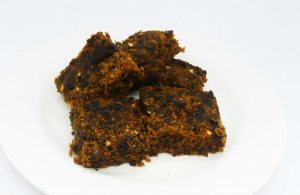Sri Lankan Christmas Cake
The traditional English Christmas fruitcake gets a makeover with spices and preserves.
Equipment
- Big mixing bowl
- Mincer or all-purpose electric chopper
- Spatula or wooden spoon or a big serving spoon
- Spice grinder, coffee grinder or mortar and pestle
- Grater
- 2 small plates or saucers
- 3 small bowls
- Measuring jug
- Electric cake mixer
- Tablespoon
- Egg beater
- Baking paper or greaseproof paper
- 2 24cm x 24 cm x 8cm square baking tins
- Bamboo or metal skewer or a knife
Ingredients
- 500 g raisins
- 500 g sultanas
- 250 g currants
- 250 g ginger preserve
- 250 g chow chow preserve
- 250 g pumpkin preserve
- 250 g mixed candied peel
- 250 g pineapple
- 200 g cashew nuts
- 1 tsp ground cardamom
- 1 tsp ground cinnamon
- 1 tsp ground cloves
- 1/2 tsp ground nutmeg
- 50 g plain flour
- 1 kg caster sugar
- 500 g butter
- 2 limes, the skin grated
- 500 g fine ground semolina (called soogee or rulang)
- 12 egg yolks
- 6 egg whites
- 50 ml brandy
- 50 ml rosewater
- 50 ml honey
- 50 ml pineapple juice
- 1 dash vanilla essence
Instructions
- Pre-heat your oven to 200C
- If you are using butter straight out of the fridge take it out now and leave it to soften a little while you do the next steps.
- Separate the 12 eggs putting the 12 yolks into one bowl, and putting 6 egg whites into another bowl. You don't need the other 6 egg whites so you can either throw them away or keep them in the fridge to use in a meringue.
- Mix together 1 tsp ground cardamom, 1 tsp ground cinnamon, 1 tsp ground cloves and 1.2 tsp ground nutmeg. Put the mixture on a plate or saucer.
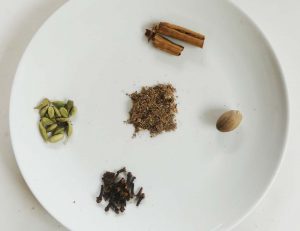
- Measure out and mix in a bowl 50 ml brandy, 50 ml rosewater, 50 ml honey and 50 ml pineapple juice.
- Grate the skin of 2 limes and put it on a plate or saucer.
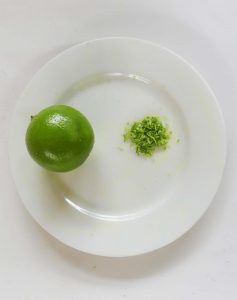
- Mince or chop 500 g raisins, 500 g sultanas, 250 g currants, 250 ginger preserve, 250 g chow chow pickle, 250 g pumpkin preserve, 250 g mixed candied peel and 250 g pineapple. You can do each of these separately or in batches together depending on the capacity of your mincer or chopper.
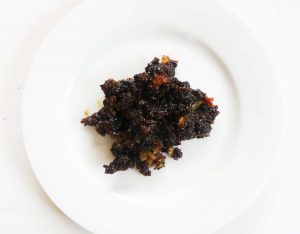
- Put the minced fruit and preserves into a large mixing bowl. If you have minced the ingredients separately, mix them well now in the bowl with a spatula/ wooden spoon/ or serving spoon. Use your hands instead if you like.
- Crush, chop or mince 200 gms of cashews.
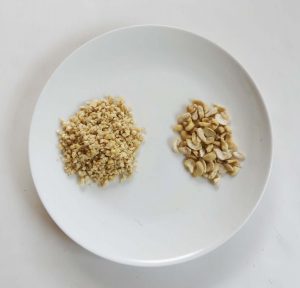
- Add the crushed cashews to the fruit mince and mix thoroughly again.
- Dust this with the 50 g plain flour and mix thoroughly again.
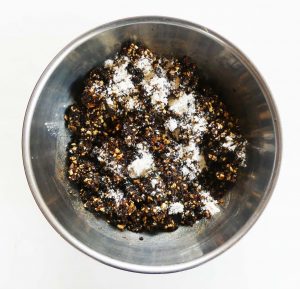
- If you are using a block of butter, cut it into cubes to make it easier to use in the next step.
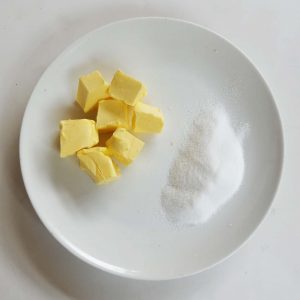
- Put the butter into the mixing bowl of your electric mixer.
- Starting at the lowest speed you can, turn the mixer on.
- Add the 1 kg caster sugar a tablespoon at a time letting it mix well with the butter each time.
- Keep beating the butter and sugar together until you get a very pale batter. This may take 15 minutes.
- Turn the mixer to a medium speed and keep blending the batter for another 5 - 10 minutes.
- Turn the mixer down to its lowest speed.
- Add the 12 egg yolks one at a time, blending each one well into the batter.
- Keep the mixer on and add the 500 g semolina a tablespoon at a time letting it mix in well between each spoon.
- When all the semolina has been mixed in, add the ground spices to the batter.
- When the spices are mixed in well - a minute or two - stop the mixer, remove the bowl with the batter.
- Add the batter to the fruit mince in the large bowl. Mix the batter and the mince together well using a spatula/wooden spoon/serving spoon or your hands.
- Add the grated lime skin and mix it in well..
- Add the 50 ml brandy, 30 ml honey, 50 ml rosewater and 50 ml pineapple juice to the batter in the large bowl. Mix them in well.
- Beat the 6 egg whites till they are stiff and from little peaks when you lift the beater out of the mixture.
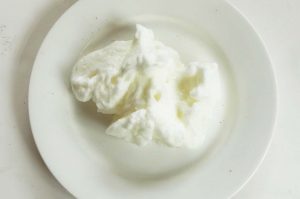
- Add the beaten 6 egg whites to the batter one tablespoon at a time. Fold it in to the batter. this means that you mix it in gently and not stirring rapidly.
- Cut 6 squares of baking paper about 2 cms bigger than the base of your baking tins.
- Cut 4 strips of baking paper about double the height of your baking tins and enough to go around each time with about 6 cms overlap.
- Line the bottom of each baking tin with 2 of the square pieces you baking paper. You should have enough to cover the bottom and have a small raised edge around the side of each tin.
- Line the inside walls of the baking tins with 2 layers each of the strips of baking paper. Run the strips inside the raised edge of the baking papers on the bottom of the tin. What you are aiming for is to make sure that very little or preferably no batter leaks out and touches the bottom or sides of the tin directly.
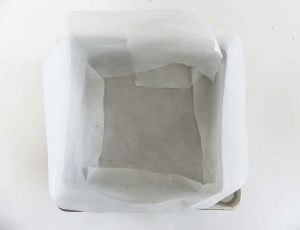
- Pour half the batter into one tin and half into the other. I find it is easiest to do this a little at a time alternating pouring the batter between the two tins: you can judge better that you are getting an equal amount of batter into each tin.
- As you pour the batter, use the spatula/wooden spoon.serving spoon to push the batter right up into the corners of the tins.
- When all the batter has been poured, level off the batter in each tin with the spatula.wooden spoon.serving spoon till the top is as flat as you can get it.
- Trim the baking paper on the sides of the tins to just above the top of each tin.
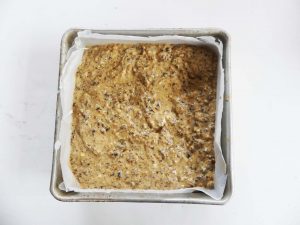
- Put the tins in the oven on the lowest shelf you can if using an electric oven or the middle shelf if you are using a gas oven.
- After 10 minutes, turn the oven down to 180C.
- After 45 minutes check the cakes. They should now have a slightly firm thin layer on the top while underneath this will still be gooey. Take the tins out and cover each cake with one of the 2 remaining square pieces of baking powder. If the top of the cakes is still a little wet or stick, leave them for another 10 minutes and then take them out and cover the tops. The idea here is to stop the top from browning too much.
- Put the cakes back in the oven and let them cook for another 45 minutes.
- Take the cakes out of the oven. Lift off the top square of baking paper.
- Take a thin bamboo or metal skewer and gently push the point into the middle of each cake.
- Take the skewer out and see if there is any wet batter sticking to it or if it comes out clean.
- If there is batter on the skewer, put the baking paper back on the cakes and put them in the oven again. Leave the cakes for 15 minutes and do the test with the skewer again.
- When the skewer comes out clean the cakes are done.
- Leave the cakes in the oven with the baking paper covering the tops. Turn the oven off.
- Leave it to cool. Turn the cakes out of the baking tins and store. Cut them into small squares to serve.
